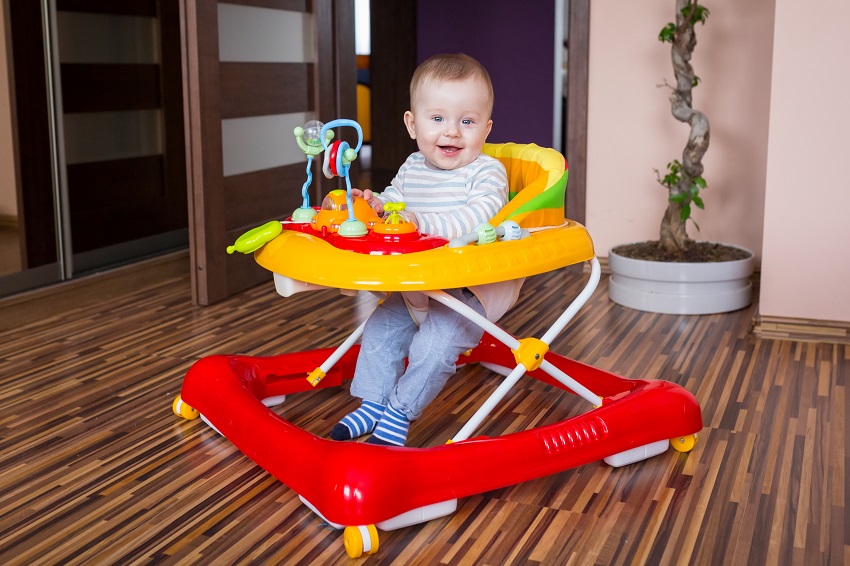Did you know that baby walkers send thousands of children to the hospital each year? That’s right. Instead of assisting movement, they might just serve to cripple it! In fact, most of these ‘walker injuries’ happen when the parents or caretakers are not even watching. There’s not enough time for them to respond to the situation. According to the AAP (American Academy of Pediatrics), a child in a walker can move more than 3 feet in a mere second. Although people might tell you it’s the right age for baby walkers when your child is anywhere between 4 to 12 months, that piece of advice is best left aside.
Why Baby Walkers are Unsafe
Baby walkers are known to cause injuries in children. Here’s a look at the common ways those injuries can occur.
Falling down Stairs
Walkers for babies going down stairs? Not a good idea.
The vast majority of injuries with baby walkers occur when a baby falls down the stairs in their baby walker. In fact, a study in Pediatrics shows that over 74 percent of the injuries reported were from falling down stairs.
The loss of balance
Children gliding fast on the floor in their baby walkers can lose their sense of balance as they might find that ‘high speed’ most overwhelming.
Burns
The usage of walkers for babies might just lead to them getting burned. The reason is simple: they can reach places they otherwise would never be able to, and get burned by things like radiators or the kitchen stove. They might even pull the tablecloth and spill hot coffee all over themselves.
It can make walking more difficult
People have their children use baby walkers so they can learn to walk with a greater sense of ease. However, this can actually be detrimental as it severely hampers the child’s ability to pull themselves up to stand and balance their weight. This is far more important than the mere usage of legs to walk.
Alternatives to Baby Walkers
Now that we’ve established the fact that opting for those baby walkers might not be such a great idea after all, let’s take a look at what an alternative for that baby walker might be, from this list of the best alternatives to baby walkers.
Stationary Activity Centers. These most closely resemble the baby walkers you want to avoid, but they are devoid of those unsafe wheels. Generally, they are made of a round seat with your baby in a harness in the middle.
Pros: While in the activity center, your baby can reach and play with toys while safely bouncing up and down.
Baby Jumpers. These are designed to support your baby and lay a foundation for that ‘walking’ to follow.
Note: You will find several stationary activity centers that double as jumpers, so you might wish to choose one in accordance with the same.
Pros: Children can bounce and jump with safety, while in those baby jumpers
Push Toys. When your baby is on the verge of taking their first steps, these will provide them some invaluable assistance to do just that.
Tip: Ensure you choose a push toy with a sturdy handle that is the right size for your baby’s hands.
Note: You have to stay close to your child while they use these, as they have wheels.
Pros: If you’re budget-conscious, these are the perfect choice, Also, they take up less space!
When should a Baby learn to walk?
A lot of parents feel that babies should learn to walk by themselves at the age of 12 months, but in fact anywhere from 9 to 18 months is the normal range for them to start walking. You might find your baby taking a few steps one day, and then crawling again the next. There is no preordained timeline, really, between a baby’s first steps and their walking independently. It can be hundreds of steps of assisted walking, before they can finally walk on their own.
Tips to Assist your Kids to walk without a Baby Walker
Besides using an alternative to that baby walker, there’s plenty of things you can do to ease your child into that milestone walking stage.
- Let them go barefoot most of the time. Going barefoot is great for kids because the muscles in their feet have an easier time grasping the ground. Besides, it makes for a great sensory experience.
- Take baby steps. Not you, but baby! Ensure you don’t push them too hard. In the beginning, they will only be able to take one or two steps at a time. Stay close and gradually increase the distance between you and them as they gain more confidence and take more steps.
- Motivate them with words and smiles. The biggest encouragement that a child can get is an earnest smile from their parents. Encourage them with words that motivate them to push harder. Even if they manage to take only a single step.
- Gradually reduce support. Of course you will be holding your baby under their arms, hands or even their trunk, when assisting them to walk in those initial stages. Over time, as they gain muscle strength, you will find them needing less and less support. This is when you need to decrease the assistance you erstwhile lent them, so they can effectively make that transition to walking on their own.
As we have seen in this article, there are several things you can do to help your baby take those precious first steps, and a baby walker clearly isn’t one of them. Trust the process of their learning to walk, and in time you will find your little ones walking all on their own, ready to take on the world with a newfound sense of confidence. Visit EuroKids to learn more.















